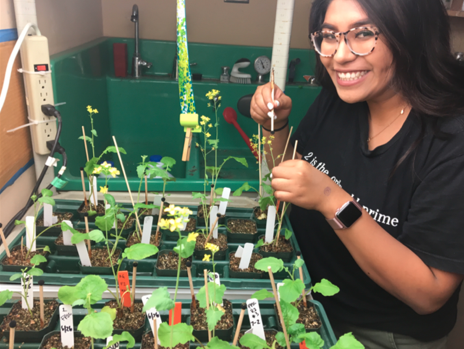Q: What subject do you teach and where?
A: I teach 9th-12th grade Mathematics at Hanford High School in California.
Q: How long have you been a full-time teacher?
A: 2019 is my second year of full-time teaching.
Q: Can you tell us a little about your STAR research experience?
A: Over the summer, I worked at San Luis Obispo in a genetics lab. We identified an albino mutant in the plant Brassica rapa (turnip, napa cabbage). This recessive mutation could provide insights into the photosynthetic pathways of all plants. To find more information on the albino mutant, we extracted DNA from the F2 population (that we grew at the beginning of our research) using PCR markers.
Q: What do you enjoy most about your job as a teacher?
A: As a math teacher, I found that my biggest obstacle was getting students to change their mindset about mathematics. Most students have a mindset of either “you’re good at math or bad at math.” Due to this, they categorize themselves under the “bad at math” category. I enjoy witnessing my students change their mindset about mathematics throughout the year. I like hearing things like, “Ohh, that makes sense. That’s easy. I like math. Math isn’t so hard.” Because no one is “bad at math.” Everyone is capable of “doing math,” as long as they are given the tools to solve the problem. I enjoy providing them with those tools.
Q: How has your STAR experience influenced your classroom teaching and the ways that you engage your students in STEM disciplines and research practices?
A: Through my STAR experience, I have been able to answer the question of “when will I ever need this in real life?” I found that my students were constantly looking for a reason to learn. They wanted to know why it was important for them to know how to factor polynomials, divide numbers and master any math skill. They needed a purpose to learn and a reason to continue learning. Through STAR, I was able to answer their questions. I was able to provide them with specific scenarios that were used in their daily lives or that they would use in the future. I was able to foster curiosity and create discussions based on applied mathematics. And slowly but surely, I began to see my students get excited about learning mathematics. I used what I learned in the workshops, conversations we had in the lab and use them in my classroom. STAR completely changed how I taught in my classroom and made me more mindful.
Q: How have the personal and professional connections that you made during your STAR experience benefited you, your students, and/or your school community?
A: Whenever I explain to my students what I did over the summer, they are wide-eyed. They start to think about STEM differently and how being in a STEM field opens so many opportunities. They are intrigued by how although I have a math degree, I worked with plant genetics. Through STAR, my students don’t just see me as an educator but also a researcher. They begin to see the power of learning. They start to understand that there is power in knowing and growing. The professional connections I have made through STAR has shown me what a scientist looks like. It showed me that we are all scientists at heart and that curiosity moves mountains. We are all problem solvers, we are all critical thinkers, we are all mathematicians.

